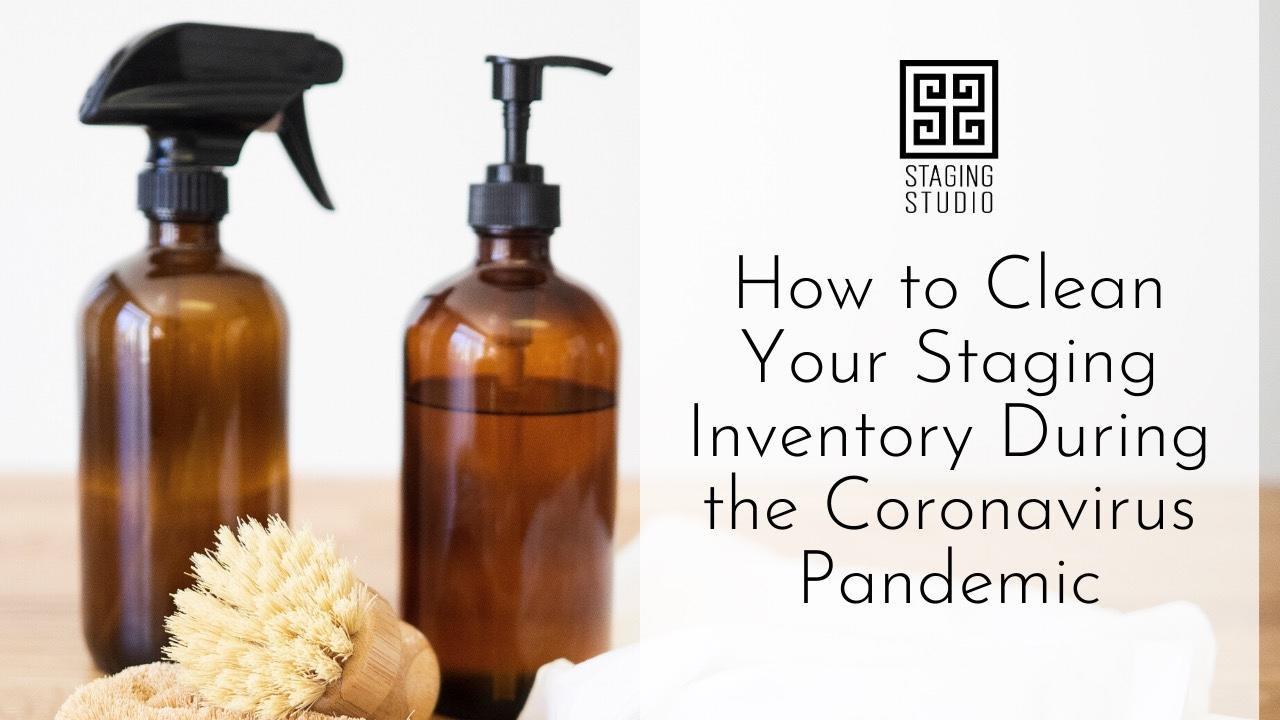How to Clean Your Home Staging Inventory During the Coronavirus Pandemic
Mar 30, 2020
If the cleaning supply aisle in the grocery store is any indication, the disinfection of surfaces has become a high priority for us all. Our job as home stagers involves placing furniture in homes, begging the obvious question of what steps we need to take to keep us and our clients safe. Maintaining a clean warehouse and inventory is always important, but the coronavirus pandemic has made sanitizing every surface a concern. This blog will teach you how to disinfect your home staging inventory.
There is still a lot that we don't know about the COVID-19 virus, but there is also a lot that we do know. First, according to the CDC, the most common way COVID-19 infection spreads is person-to-person and "happens most frequently among close contacts (within about 6 feet). This type of transmission occurs via respiratory droplets. On the other hand, transmission of novel coronavirus to persons from surfaces contaminated with the virus has not been documented."1
This means that while evidence suggests that the virus may remain viable for hours to days on surfaces, there are no known cases of transmission this way.
Researchers have estimates that are all over the map regarding how long the virus lives on surfaces - anywhere from 3 hours to 9 days, depending on the study, the type of surface, and environmental conditions like temperature and humidity. It seems to live longer in low temperatures and high humidity; less time in higher temperatures and lower humidity.
A study by the New England Journal of Medicine found that the coronavirus can be viable on different surfaces:
-Copper up to 4 hours
-Cardboard up to 24 hours
-Plastic and steel up to 72 hours
We still want to do our part to keep our client's concerns met and our communities safe by disinfecting our inventory to the best of our ability. So, what does that look like?
The CDC recommends that community members practice routine cleaning of frequently touched surfaces (for example: tables, doorknobs, light switches, handles, desks, toilets, faucets, sinks) with household cleaners and EPA-registered disinfectants that are appropriate for the surface, following label instructions.
The guidelines for households where someone is isolated, who is suspected or confirmed to have COVID-19, are a different matter and that level of precaution does not need to be taken for the community at large. You can learn more about those recommended measures here.
We all have several types of surfaces in our inventory from upholstered sofas, glass accessories, to a flokati throw. Even with differing information about how long the novel coronavirus can survive on each type of surface, here are several precautions to take:
- Leave items in homes 72 hours+ past when the last person was there.
- After de-staging, leave accessories, etc in your bins, untouched, for 72 hours.
- Employees should wash hands frequently.
- Practice social distancing between your team members, and between them and others.
- Provide hand sanitizer and disinfecting wipes for your team to use on phones, steering wheels, gas pump, door handles, etc.
- Wipe down surfaces within the staged home as you leave, such as door handles and hard surfaces. Here is a current list of products that meet EPA’s criteria.
- A bleach solution that is highly effective in destroying viruses can be prepared by mixing 5 tablespoons (one-third cup) of bleach per gallon of water or 4 teaspoons of bleach per quart of water.
- Never combine bleach with ammonia or other cleaning products as this can produce toxic fumes.
- The virus does not seem to live long on porous surfaces like fabric. Launder items that you can, using the hottest temperature they can tolerate and dry completely.
- If the item cannot be washed, you may still be able to run it through a heat cycle in the dryer.
- Simply spraying with Lysol or another disinfectant is also effective.
- Be sure to check fabric recommendations so that you do not ruin your inventory.
- Obey your local or state public health policies regarding any requirements to shelter in place.
Our staging company, BY Design Home Staging, does not put our inventory into occupied homes --only vacant homes-- which greatly lessens the exposure. This is our business model, but we know a lot of successful stagers that do place their items in occupied homes. The beauty of owning your own company is that you get to decide what suits you best! However, during the current coronavirus pandemic, you may consider adjusting your practices to only having inventory in vacant homes and limiting occupied staging to e-consultations.
Let’s be smart and make informed decisions about COVID-19. Take heart, we will get through this!!
Staging Studio has created many resources for home stagers, designers, and real estate agents during this pandemic. For all of the information, go here: www.stagingstudio.com/coronavirus
Don't miss our next blog like this!
Join to receive the latest news for home stagers.



